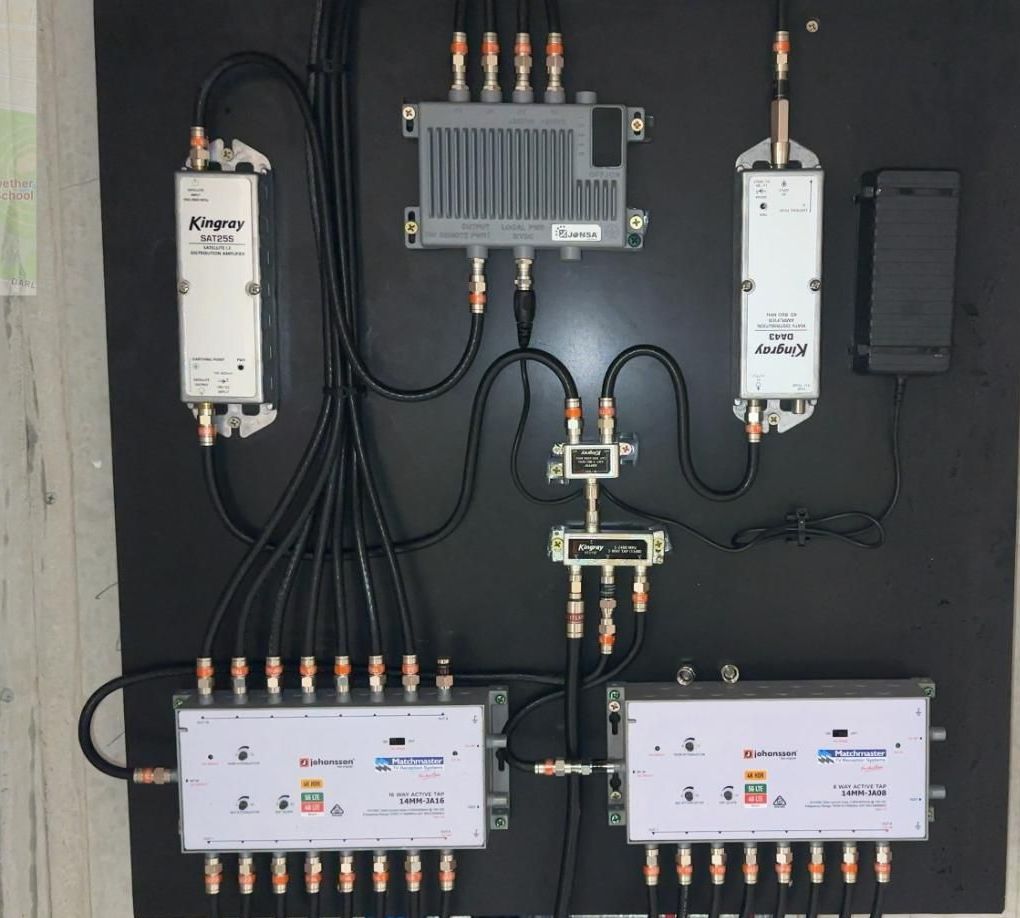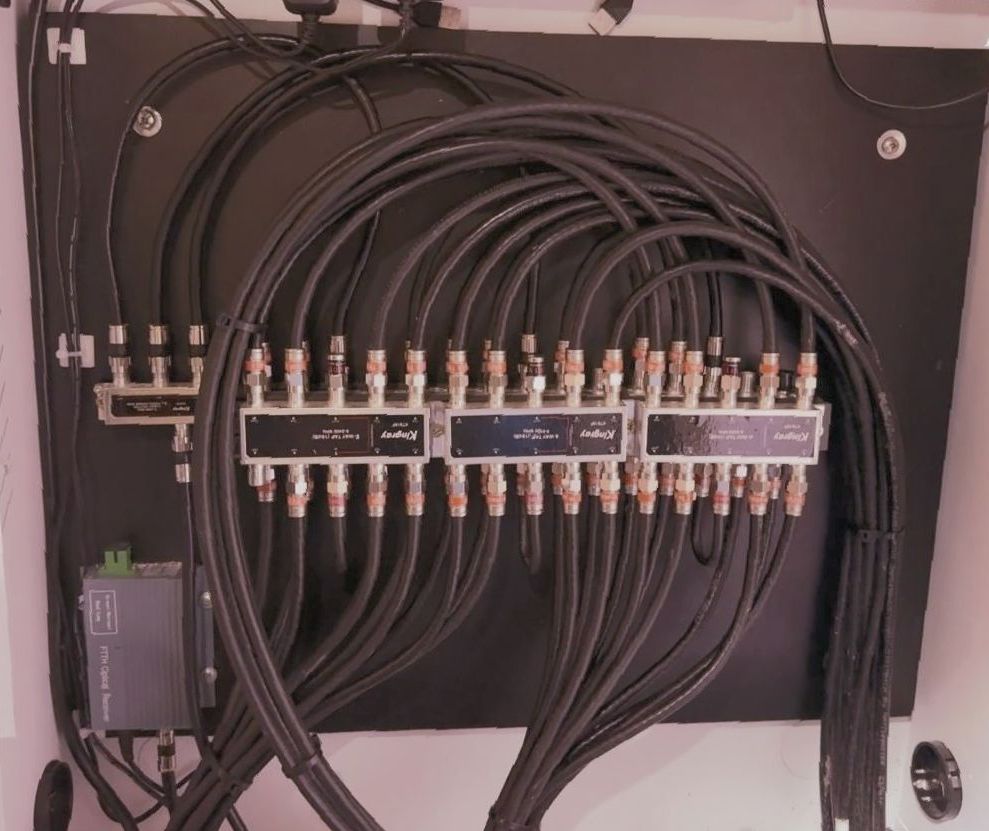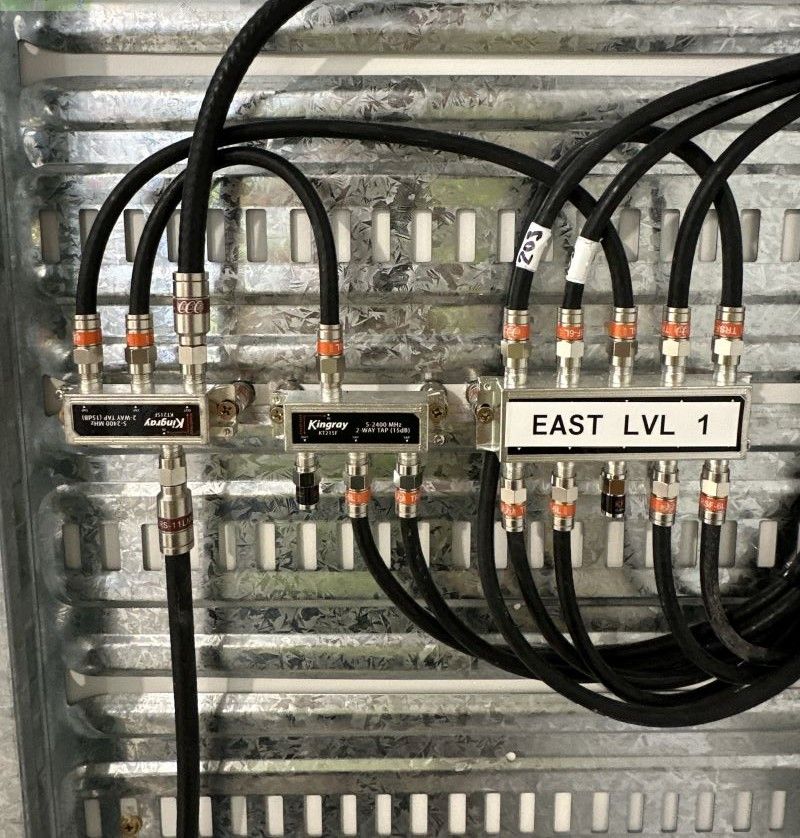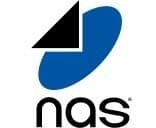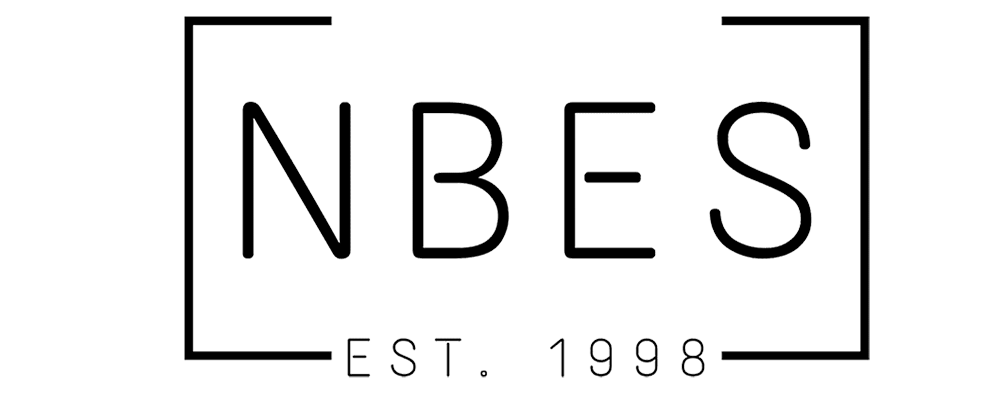Commercial MATV Systems in Newcastle
- Foxtel compliant FTA / Pay TV MATV System designs, installations, repairs and maintenance.
- Over 50 years' experience in commercial projects
- Full-service support from install to upgrades
Request a Call Back
Thank you for contacting MATV Systems Australia.
We will be in touch soon.
Oops, there was an error sending your message.
Please try again later.
Newcastle MATV Systems
When you're managing a commercial property, aged care facility or multi-dwelling unit in Newcastle, having a reliable, scalable and compliant MATV system is essential. At MATV Systems, we specialise in delivering end-to-end solutions that support everything from Foxtel integration to custom in-house channels. With over 50 years of experience and Foxtel design partner status, we understand the real-world challenges of managing complex TV distribution systems and how to solve them quickly and efficiently.
Plus, we're now listed on MRI Strata Master Connect (SMATA), the platform trusted by strata management companies to source professional contractors for the properties they manage.
- Fully compliant MATV and CATV solutions
- Fast fault diagnosis and emergency repairs
- Tailored support for retirement, strata, and hospitality
From hospitals and high-rises to van parks and retirement villages, our commercial services are designed with your audience and infrastructure in mind. Need expert help? Call
0412 790 222 to speak with a technician who understands your environment, whether you're in Port Macquarie, Forster Tuncurry, Maitland, the Hunter Valley, Byron Bay, Brisbane or Gold Coast.
Our MATV Specialities
We install MATV systems for commercial sites, including aged care facilities and retirement villages, with features like internal info channels for bulletins, menus and updates. Residents can view “What’s On” listings, bus timetables, activity calendars, club notices and doctor visit schedules directly on their TVs.
If you are interested in an obligation Free Demonstration of our "in House Channel" system please call us any time 0412 790222
Depending on site requirements, we install hardline or fibre systems with transmitters and receivers. Our solutions support Smart TV-compatible IPTV, Apple TV integration and “One Wire” delivery for whole-facility coverage.
MATV System Installations
We offer full-service MATV system installations designed for modern commercial properties. Whether you're setting up a retirement village, hotel, or multi-storey development, we tailor the entire process, from site assessment to final handover, to meet your unique signal requirements. Our team handles design, equipment supply, and installation, including headend setup, internal info channels, and compatibility with CAT 5/6 or fibre networks. Want to offer streaming or specialty satellite content like Christian channels? We can do that too. Signal logging is included to simplify future maintenance and performance tracking.
MATV System Repairs
We repair and upgrade MATV systems across a range of commercial properties, including those using IPTV, hotel-managed TV systems, and Apple TV configurations. Our technicians work with legacy and modern equipment, and we stock a range of rare, hard-to-source components for rapid repairs. This includes RG7 (DSC 21 copper cable), .500, .750 and .412 hardline pin connectors, as well as RBS Green Trunk Cable connectors. These are all essential for keeping your system running smoothly without long wait times for parts.
MATV Maintenance
To ensure your MATV system remains reliable long-term, we offer scheduled maintenance supported by formal Service Level Agreements (SLAs). For high-dependency environments like aged care facilities and retirement villages, we also provide headend equipment with remote monitoring capabilities. This allows us to detect issues before they cause outages, helping you maintain uninterrupted service for residents, guests or tenants.
MATV System Upgrades
If your system is due for an upgrade, we can transition you to a more modern setup with features like Smart TV compatibility, integrated Apple TV functionality, and centralised IPTV distribution, all without requiring set-top boxes. For aged care and retirement communities, upgrades often include adding internal information channels to display live announcements, events, and resident communications. Call us now to see as obligation free demonstration of our "in house ", easy to use, Info Channel , live on your TV Network.
We can also overhaul your cable infrastructure, replacing outdated connections with high-performance fibre systems or reconfiguring your network using our efficient “One Wire” technology. If component issues are causing system delays, we carry rare parts such as RG7 and other hardline pin connectors to complete upgrades without downtime.
Want to integrate streaming service or add in-house info channels?
Call us for obligation free demonstration.We’ll help you future-proof your system and enhance the user experience for residents, guests, or patients.
How a Typical MATV System Works
- A UHF or VHF TV antenna (depending on the Transmission site) and /or satellite dish is appropriately positioned to receive digital TV signals (DVBT)
- Signals received by the aerial or dish are then processed using the Head End equipment.
- A distribution network consisting of Amplifiers, Taps, Splitters and trunk cables (typically RG11 Quad or more recently single mode fibre) and drop cables (typically RG6 Quad) then delivers all television signals to wall outlets in each apartment / room. Configuration of the distribution network will depend on the number of dwellings in a ‘Horizontal site’ and/or floors at the premises in a ‘Vertical site.’
For expert advice on your MATV needs, why not call us now to arrange for one of our friendly MATV system Experts to help design a new MATV solution customised to suit your situation.
For a more in-depth look at the components of an MATV system, see below.
Modulators
Many commercial premises such as hotels, retirement villages, and holiday parks now utilise their MATV system to supply additional services or “in house” programmes and information services to their customers. The channels could be Village/ACF/Resident information, ethnic or religious programs, PAY TV channels, CCTV cameras etc. These modulated channels can be SD ( Standard Def) or HD ( High Def)
Additional DVBT “channels” can be modulated (using a programmable modulator) onto a 7Mhz carrier and integrated into the MATV System. This carrier can consist of a MUX of several channels that the TV receivers can unpack and allocate as individual channels with individual LCNs (Logical Channel Number).
MATV Head End
The Head End of a MATV system usually consists an AGC Amplifier (Single Channel or Processor) that receives the broadcast signals and processes them to filter unwanted signals (LTE or fortuitous broadcasts). These processors can shift frequencies if required. They can also allow the combination of any modulated services.
AGC (Automatic Gain Control) is essential in any large MATV System as it locks the output irrespective of whether the input signal varies up and down with weather conditions and the like. Also included in the Head End may be a Launch Amplifier to amplify the signals to compensate for distribution losses before further amplification that may be required in the system. In a large system there may be many Line Amplifiers.
Regeneration MATV Headends
One of greatest allies in area where the FTA Terrestrial signal isn’t good enough to work with on one or all channels. A regeneration Head End can be utilised. It takes the poor signal and rebuilds it and modulates it onto a clean carrier. It can take a signal that is completely unusable and restore it to near perfect MER and BER.
Signal Survey
Completing a signal survey before installing the system will avoid many potential problems. By using a Field Strength Meter and test antenna, you can measure the amount of signal received on each channel. There are a number of types of antennas namely, Yagis, Phased Arrays and Log Periodic. Each has different traits and experience tells us which one we would recommend
Antenna
The quality of TV reception can be no better than the quality of the signal from the antenna. It is vital that the correct antenna be selected for the intended location.
The quality and strength of any signal are measured using a Professional FSM (Field Strength Meter). The FSM must be capable of measuring Power (in db/uv), MER (in db) , Carrier to Noise (in db) and Pre and Post BER.
The location and type of antenna to use are determined by the following:
- Proximity to the transmission tower
- Power of the transmitter
- Quality of the transmission
- Line of sight to the transmission tower
- Weather conditions
- Interference from power lines or LTE
- Directional characteristics and orientation of the antenna
- Gain and directivity of the antenna
Masthead Amplifiers
If the signal at the antenna , or the antenna is a long distance from the headend location then a masthead amplifier is required. Masthead Amplifier can amplify the signal before it reaches the distribution amplifier. It is essential that the amplifiers has a on board LTE Filter. Typically a low noise, low gain ( or enough gain to cover signal loss in the feed in cable ) Masthead is the best one to get the signal to the headend.
VAST Headend
In areas where FTA Terrestrial signal is not workable ( and even a Regeration Headend can’t solve) we can use a VAST Headend which receives FTA services via satellite (DVBS / S2 ) from the same Satellite that Foxtel use and modulates them as DVBT channels. Typically around 20 actual channels. The main channels from each Network can be selected.
MATV Distribution
To guarantee a good signal at every TV receiver connected to the system, the MATV distribution system must be well designed. Splitters, Taps and Line Amplifiers are used in the distribution system to provide the necessary signal level ( typically Signal level of > 55 db/uv and < 78db/uv and > 27db MER) and to maintain the correct impedance to each of the outputs. Calculations of losses associated with splitters, drop taps, and cable are required.
Distribution Amplifiers
Distribution or Line Amplifiers are used to increase the signal strengths to a level greater than the losses in the distribution system. Signal increase is determined by the amplifier gain, but most important is the amplifiers output.
Amplifier specs will show the maximum gain and the maximum output usually for 2 channel carriers. Most systems in Australia have at least 5 carriers ( the 5 TV Networks). Every time you double the number of carriers, the output of the amplifier has to be derated by 3db. Amplifiers further down the line also have to be derated by 3db each time one is added. The input level of an amplifier is critical, as is the balance level of the input. A difference of 6db between any carriers at the input will grossly affect its performance.
Too much signal going into an amplifier causes overloading and corruption of the data streams, which will result in pixelation or complete loss of picture. This input can be rectified with the use of attenuators (available in various values).
What is an MATV System?
MATV stands for Master Antenna Television. A MATV system enables TV signals to be distributed to a large number of TV receivers ( could be >1000 ) in a Hi Rise, Village, ACF, Gated Community, Retirement Village etc.
In simple terms, an MATV system is a network of cables and specifically designed components that process and amplify TV signals, then distribute them from one central location to all TV Outlets.
MATV systems are separated into two parts, the ‘Head End’ and the ‘Distribution System’. It is essential to carefully plan and engineer both parts using the best MATV equipment and best practice installation techniques to ensure DVBT signals are distributed with minimal loss of quality.
Without a MATV system, any premises that require multiple TVs would need to install and maintain an antenna and / or satellite dish per unit/villa. This would be expensive, not to mention unsightly. The TV reception would also suffer, because multiple antennas ( say on the roof of an MDU) could interfere with each other, causing signal issues.
An MATV system can carry digital television signals received by an aerial and / or satellite dish (both free-to-view and subscription television), FM radio and DAB (Digital Audio Broadcasting)
What is a commercial MATV system and how does it work?
A commercial MATV (Master Antenna Television) system is a shared TV signal distribution network that serves multiple units within a property, like hotels, apartment buildings, or retirement villages. Instead of each unit having its own antenna or satellite dish, a single headend or antenna receives the signal and distributes it via coaxial, fibre, or CAT 5/6 cabling. These systems can support free-to-air (FTA) channels, Foxtel, IPTV, and even internal channels for messaging or promotions. They're cost-effective, tidy, and easily scalable.
How do I know if my MATV system needs an upgrade?
Signs your system may need an upgrade include poor signal quality, compatibility issues with digital or IPTV content, frequent breakdowns, or a lack of support for modern devices. If your current headend is outdated or doesn’t support fibre or CAT 6, an upgrade can improve performance and future compatibility. An expert assessment can help determine whether a full upgrade or partial regeneration is the best option.
What are the benefits of having MATV maintenance contracts?
Maintenance contracts offer peace of mind and minimise unexpected outages. Regular inspections help identify signal loss or equipment issues early, reducing the risk of widespread disruption. Contracts often include signal logging, priority repair response, and long-term reporting. This is especially valuable for aged care homes, hospitals, and large residential complexes where TV access is essential for comfort and communication.

